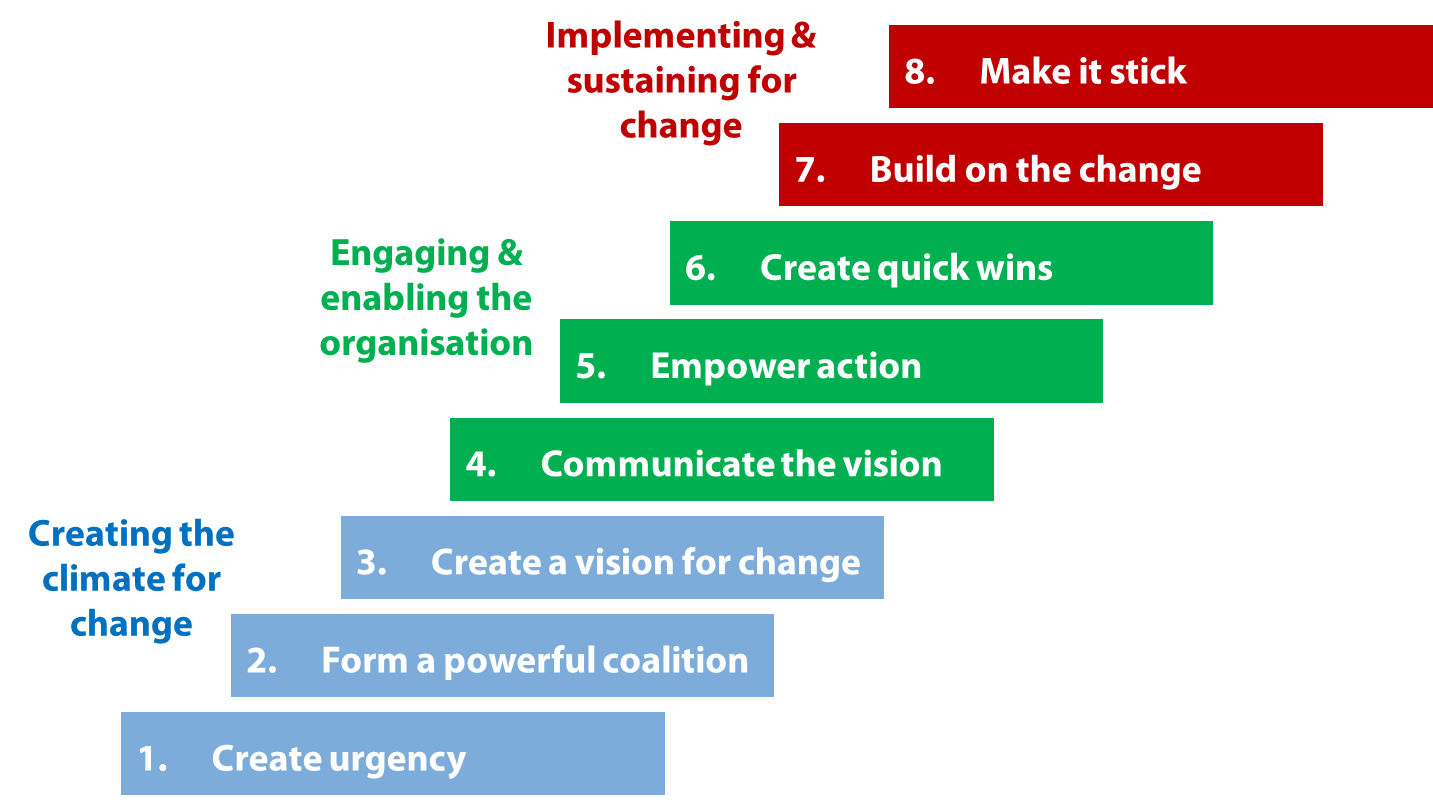Kotter
Kotter's 8-step Model of ChangeThe change model for leading change originated from more than four decades of Dr. Kotter’s observations of countless leaders and organizations as they tried to transform or execute their strategies. To successfully implement a change in an organization, Prof. J.P. Kotter has drawn up the eight change steps for change. It is important that the eight change steps (phases) are taken in a logical order.

Kotter’s 8-step Model of Change
- Strengthening a sense of necessity
Crucial to change is the awareness of necessity among all involved. Why do we have to change and what problems will be solved? Generate energy by achieving emotions such as hope, trust, optimism and enthusiasm. Emotions are the engine for change.
Kotter argues that 75 percent of a company’s management needs to “buy” the change to be successful. In other words, you have to work very step 1 and spend a lot of time and energy building urgency, before moving on to the next steps. Don’t panic and don’t jump in too quickly, as you don’t want to risk any further short-term losses – if you act without proper preparation, you can get a very bumpy ride.
- Forming a leading team
First who, then what. Leaders must be supported by a group of enthusiastic people from the full breadth of the organization. These are people with formal and informal influence, who are well rooted in the organization and have sufficient critical distance.
- Developing the right vision and strategy
Make the change vision concrete, realistic and simple. Look for the essence: what change is it about and why does the outside world want that change from us (The Why). Look for common values and underlying assumptions that form the basis for the desired behavior that can be used to realize the change. Create a plan based on common goals and desired behavior.
- Communicate vision and create safety
Communicate the change vision. In order to limit uncertainty, fear and mistrust, it is important that employees know where they stand. Inform employees about the changes in a clear and credible way. ‘Feeling safe’ is an important condition for making behaviour negotiable. Management has a crucial role to play here by being vulnerable, revealing and open. That’s where the dialogue begins.
- Empowering employees to change, provide support Develop support for the change
The most important precondition is commitment from the top: without unconditional and long-term support, any (cultural) change is doomed to fail. In addition, it is important to remove barriers that make the process of change difficult for employees or stand in the way. The effect of the change is the quality of the solution * support within the organization (E = K * A)
- Create and celebrate short-term successes
Generate short-term successes ‘quick wins’ and make these successes visible to everyone. This creates more faith in the success of the new vision and strategy.
- Do not slacken but persevere
Kotter argues that many change projects fail because victory is declared too soon. Real change runs deep. Quick wins are just the beginning of what needs to be done to achieve long-term change. After the first successes, it is important that the organization does not become overconfident and feel that the process of change has been completed. In this phase, the emphasis is on continuing the changes, tuning and fine tuning. The condition for this is that the ‘sense of urgency’ remains high. Research what works, refine the approach and transfer these changes to other organizational components. So look for a best-practice.
- Securing
Ensure the perpetuation of the new situation by embedding changes in the organization. This is mainly about the discipline and perseverance to actually do and finish things differently. The anchoring is complete if the progress on change is measured and evaluated periodically and systematically. This is often omitted and is an important reason that changes often get bogged down. After all, what is not measured is not important enough. Think not only of the hard benefits such as Lead Time, Quality and Costs, but also of the soft benefits as an employee satisfaction. Ultimately, it is the employees who make the change a success.